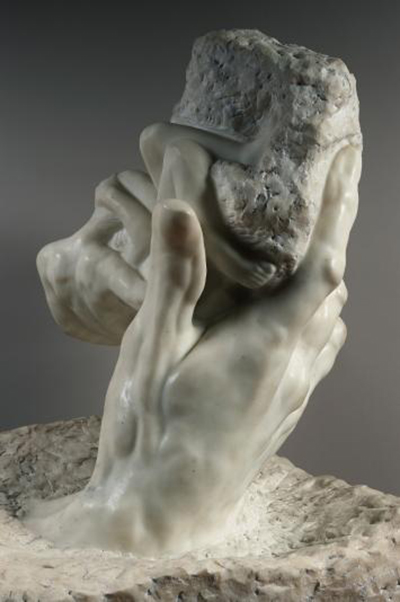Auguste Rodin was a follower of Michelangelo in elements of his style and we find examples of that here in this marble sculpture from around the early 20th century.
This piece is close to a metre tall and was originally modelled by Rodin around 1896-1902 before than being carved in 1907. The composition captures the hand of god cradling Adam and Eve. The connection to Michelangelo is specifically in how different parts of the sculpture are finished to different levels, with some parts beautifully smooth, and others being completely untouched, delivering the original rough nature of the marble. This comparison allows us to understand more about the creative process taken on by those who work with these types of materials. Whilst Rodin originally modelled the piece, several different versions were then taken from that, including one carved by Séraphin Soudbinine in 1916-1918 which is now owned by the Musee Rodin in Paris. The whole process of sculpture in which models and completed sculptures may have different contributors and be completed at different times has proven a problem for art historians, perhaps in a similar way to the medium of drawing. Painting has tended to offer a clearer lineage with each artwork fairly unique.
Research has suggested that the hand in this piece is actually Rodin's. Eve within this setting has also reminded many of Dawn in the Medici Chapel, as completed by Michelangelo. He himself inspired Rodin greatily after the latter travelled to Italy in order to study his work, alongsided that of Bernini. Whilst being entirely knowledgeable of both prior to the trip, to see both artist's sculptures in person left a much bigger mark on Rodin and he claimed to only really understand both artists after that point. The cycle of art history is full of examples such as this, where new talents take the best of what has gone before and add their own ideas, which then influence the next generations, and so the process continues. Whilst drawing on the qualities of the Renaissance and Baroque eras, Rodin was actually considered an entirely contemporary artist whose approach was initially thought of as controversial.
Séraphin Soudbinine, believed to have sculpted one of the versions of Hand of God, was a Russian artist who served as an assistant to Rodin for a number of years. It was actually a trip to Paris in 1904 which convinced him to commit to sculpture and he later received a grant from Savva Morozov for the purposes of continuing his learnings within France. He initially worked alongside Leopold Sinaeff-Bernstein before switching to Rodin in 1906, which helps us to date the piece that now resides in the Rodin Musee. Many other notable figures have passed through Rodin's studio over the years, both highly skilled assistants who would later go on to have impressive careers of their own, as well as some well known photographers who perhaps were in Paris at the time and wished to meet this charismatic figure.




